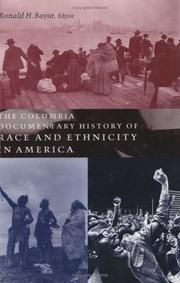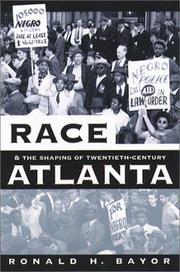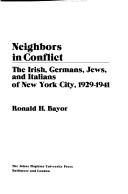| Listing 1 - 10 of 14 | << page >> |
Sort by
|
Book
ISBN: 9781421413679 9781421413686 Year: 2014 Publisher: Baltimore Johns Hopkins University Press
Abstract | Keywords | Export | Availability | Bookmark
 Loading...
Loading...Choose an application
- Reference Manager
- EndNote
- RefWorks (Direct export to RefWorks)
History of North America --- anno 1800-1999 --- United States --- Ellis Island Immigration Station (New York, NY) --- History --- Emigration and immigration --- Immigrants --- United States of America
Book
ISBN: 1421430622 142142990X 1421431025 Year: 2019 Publisher: Johns Hopkins University Press
Abstract | Keywords | Export | Availability | Bookmark
 Loading...
Loading...Choose an application
- Reference Manager
- EndNote
- RefWorks (Direct export to RefWorks)
Originally published in 1978. Millions of immigrants seeking a better life came to New York City in the nineteenth and twentieth centuries. Ronald H. Bayor's study details how the relative tranquility among the city's four major ethnic groups was disturbed by economic depression, political divisions arising out of ties with the Old Country, and factional strife stirred up by local politicians seeking ethnic votes. Also evaluated are the effects of such emotional and political issues such as Nazism and Fascism upon the allegiances of Germans and Italians; the rift in the ethnic community caused by the communist scare; and the influence of such figures such as Franklin D. Roosevelt, Father Charles Coughlin, and Fiorello La Guardia.
Italian Americans --- Jews --- German Americans --- Irish Americans --- New York (N.Y.) --- Politics and government --- Ethnology --- Irish --- Germans --- Hebrews --- Israelites --- Jewish people --- Jewry --- Judaic people --- Judaists --- Religious adherents --- Semites --- Judaism --- Italians --- History of the Americas

ISBN: 0231508409 9780231508407 0231114788 9780231119948 0231119941 Year: 2004 Publisher: New York : Columbia University Press,
Abstract | Keywords | Export | Availability | Bookmark
 Loading...
Loading...Choose an application
- Reference Manager
- EndNote
- RefWorks (Direct export to RefWorks)
All historians would agree that America is a nation of nations. But what does that mean in terms of the issues that have moved and shaped us as a people? Contemporary concerns such as bilingualism, incorporation/assimilation, dual identity, ethnic politics, "as and affirmative action, residential segregation, and the volume of immigration resonate with a past that has confronted variations of these modern issues. The Columbia Documentary History of Race and Ethnicity in America, written and compiled by a highly respected team of American historians under the editorship of Ronald Bayor, illuminates the myriad ways in which immigration, racial, and ethnic histories have shaped the contours of contemporary American society. This invaluable resource documents all eras of the American past, including black-white interactions and the broad spectrum of American attitudes and reactions concerning Native Americans, Irish Catholics, Mexican Americans, Jewish Americans, and other groups. Each of the eight chronological chapters contains a survey essay, an annotated bibliography, and 20 to 30 related public and private primary source documents, including manifestos, speeches, court cases, letters, memoirs, and much more. From the 1655 petition of Jewish merchants regarding the admission of Jews to the New Netherlands colony to an interview with a Chinese American worker regarding a 1938 strike in San Francisco, documents are drawn from a variety of sources and allow students and others direct access to our past. Selections include Powhatan to John Smith, 1609 Thomas Jefferson-"Notes on the State of Virginia" Petition of the Trustees of Congregation Shearith Israel, 1811 Bessie Conway or, The Irish Girl in America German Society in Chicago, Annual Report, 1857-1858. "Mark Twain's Salutation to the Century" W. E. B. DuBois, "Of Our Spiritual Strivings" NAACP on Black Schoolteachers' Fight for Equal Pay Malcom X speech, 1964 Hewy Newton interview and Black Panther Party platform Preamble-La Raza Unida Party Lee lacocca speech to Ethnic Heritage Council of the Pacific Northwest, 1984 Native American Graves and Repatriation Act, 1990 L.A. riot-from the Los Angeles Times, May 3, 15, 1992; Nov. 16, 19, 1992 Asian American Political Alliance President Clinton's Commission on Race, Town Meeting, 1997 Louis Farrakhan-"The Vision for the Million Man March"
History --- Social sciences --- HISTORY / United States / General. --- Behavioral sciences --- Human sciences --- Sciences, Social --- Social science --- Social studies --- Civilization --- Annals --- Auxiliary sciences of history --- Race relations. --- United States --- ABŞ --- ABSh --- Ameerika Ühendriigid --- America (Republic) --- Amerika Birlăshmish Shtatlary --- Amerika Birlăşmi Ştatları --- Amerika Birlăşmiş Ştatları --- Amerika ka Kelenyalen Jamanaw --- Amerika Qūrama Shtattary --- Amerika Qŭshma Shtatlari --- Amerika Qushma Shtattary --- Amerika (Republic) --- Amerikai Egyesült Államok --- Amerikanʹ Veĭtʹsėndi︠a︡vks Shtattnė --- Amerikări Pĕrleshu̇llĕ Shtatsem --- Amerikas Forenede Stater --- Amerikayi Miatsʻyal Nahangner --- Ameriketako Estatu Batuak --- Amirika Carékat --- AQSh --- Ar. ha-B. --- Arhab --- Artsot ha-Berit --- Artzois Ha'bris --- Bí-kok --- Ē.P.A. --- EE.UU. --- Egyesült Államok --- ĒPA --- Estados Unidos --- Estados Unidos da América do Norte --- Estados Unidos de América --- Estaos Xuníos --- Estaos Xuníos d'América --- Estatos Unitos --- Estatos Unitos d'America --- Estats Units d'Amèrica --- Ètats-Unis d'Amèrica --- États-Unis d'Amérique --- Fareyniḳṭe Shṭaṭn --- Feriene Steaten --- Feriene Steaten fan Amearika --- Forente stater --- FS --- Hēnomenai Politeiai Amerikēs --- Hēnōmenes Politeies tēs Amerikēs --- Hiwsisayin Amerikayi Miatsʻeal Tērutʻiwnkʻ --- Istadus Unidus --- Jungtinės Amerikos valstybės --- Mei guo --- Mei-kuo --- Meiguo --- Mî-koet --- Miatsʻyal Nahangner --- Miguk --- Na Stàitean Aonaichte --- NSA --- S.U.A. --- SAD --- Saharat ʻAmērikā --- SASht --- Severo-Amerikanskie Shtaty --- Severo-Amerikanskie Soedinennye Shtaty --- Si︠e︡vero-Amerikanskīe Soedinennye Shtaty --- Sjedinjene Američke Države --- Soedinennye Shtaty Ameriki --- Soedinennye Shtaty Severnoĭ Ameriki --- Soedinennye Shtaty Si︠e︡vernoĭ Ameriki --- Spojené staty americké --- SShA --- Stadoù-Unanet Amerika --- Stáit Aontaithe Mheiriceá --- Stany Zjednoczone --- Stati Uniti --- Stati Uniti d'America --- Stâts Unîts --- Stâts Unîts di Americhe --- Steatyn Unnaneysit --- Steatyn Unnaneysit America --- SUA (Stati Uniti d'America) --- Sŭedineni amerikanski shtati --- Sŭedinenite shtati --- Tetã peteĩ reko Amérikagua --- U.S. --- U.S.A. --- United States of America --- Unol Daleithiau --- Unol Daleithiau America --- Unuiĝintaj Ŝtatoj de Ameriko --- US --- USA --- Usono --- Vaeinigte Staatn --- Vaeinigte Staatn vo Amerika --- Vereinigte Staaten --- Vereinigte Staaten von Amerika --- Verenigde State van Amerika --- Verenigde Staten --- VS --- VSA --- Wááshindoon Bikéyah Ałhidadiidzooígíí --- Wilāyāt al-Muttaḥidah --- Wilāyāt al-Muttaḥidah al-Amirīkīyah --- Wilāyāt al-Muttaḥidah al-Amrīkīyah --- Yhdysvallat --- Yunaeted Stet --- Yunaeted Stet blong Amerika --- ZDA --- Združene države Amerike --- Zʹi︠e︡dnani Derz︠h︡avy Ameryky --- Zjadnośone staty Ameriki --- Zluchanyi︠a︡ Shtaty Ameryki --- Zlucheni Derz︠h︡avy --- ZSA --- Η.Π.Α. --- Ηνωμένες Πολιτείες της Αμερικής --- Америка (Republic) --- Американь Вейтьсэндявкс Штаттнэ --- Америкӑри Пӗрлешӳллӗ Штатсем --- САЩ --- Съединените щати --- Злучаныя Штаты Амерыкі --- ولايات المتحدة --- ولايات المتّحدة الأمريكيّة --- ولايات المتحدة الامريكية --- 미국 --- Race relations --- Ethnic relations --- Spojené obce severoamerické --- États-Unis --- É.-U. --- ÉU --- Social sciences / Anthropology / Cultural. --- Social sciences / Discrimination and amp/ Race relations. --- Social sciences / Minority Studies.

ISBN: 0807860298 0585023603 9780585023601 9780807860298 0807822701 9780807822708 0807848980 9780807848982 9798890872753 Year: 1996 Publisher: Chapel Hill : University of North Carolina Press,
Abstract | Keywords | Export | Availability | Bookmark
 Loading...
Loading...Choose an application
- Reference Manager
- EndNote
- RefWorks (Direct export to RefWorks)
Atlanta is often cited as a prime example of a progressive New South metropolis in which blacks and whites have forged "a city too busy to hate." But Ronald Bayor argues that the city continues to bear the indelible mark of racial bias. Offering the first comprehensive history of Atlanta race relations, he discusses the impact of race on the physical and institutional development of the city from the end of the Civil War through the mayorship of Andrew Young in the 1980s. Bayor shows the extent of inequality, investigates the gap between rhetoric and reality, and presents a fresh analysis of the legacy of segregation and race relations for the American urban environment. Bayor explores frequently ignored public policy issues through the lens of race--including hospital care, highway placement and development, police and fire services, schools, and park use, as well as housing patterns and employment. He finds that racial concerns profoundly shaped Atlanta, as they did other American cities. Drawing on oral interviews and written records, Bayor traces how Atlanta's black leaders and their community have responded to the impact of race on local urban development. By bringing long-term urban development into a discussion of race, Bayor provides an element missing in usual analyses of cities and race relations.
Urban policy --- United States Local History --- Regions & Countries - Americas --- History & Archaeology --- Cities and state --- Urban problems --- City and town life --- Economic policy --- Social policy --- Sociology, Urban --- City planning --- Urban renewal --- Atlanta (Ga.) --- Race relations.
Book
ISBN: 0190626186 0190612886 0199983151 9780190626181 9780190612887 9780199983155 Year: 2013 Publisher: New York : Oxford University Press,
Abstract | Keywords | Export | Availability | Bookmark
 Loading...
Loading...Choose an application
- Reference Manager
- EndNote
- RefWorks (Direct export to RefWorks)
The Oxford Handbook of American Immigration and Ethnicity explores how Americans think of themselves and how science, religion, period of migration, gender, education, politics, intermarriage, and occupational mobility shape both this image and American life. Since the 1965 Immigration Act opened the gates to newer groups, historical writing on immigration and ethnicity has evolved over the years to include numerous immigrant sources and to provide trenchant analyses of American immigration and ethnicity. For the first time, this handbook brings together twenty-nine leading scholars in the field to make sense of all the themes, methodologies, and trends that characterize the debate on American immigration.
Immigrants --- Ethnicity --- Nationalism --- History. --- United States --- Emigration and immigration --- Ethnic relations --- Race relations --- History
Book
ISBN: 0801823706 Year: 1979 Publisher: New York (N.Y.): Hopkinson and Blake
Abstract | Keywords | Export | Availability | Bookmark
 Loading...
Loading...Choose an application
- Reference Manager
- EndNote
- RefWorks (Direct export to RefWorks)

ISBN: 0801820243 Year: 1978 Publisher: Baltimore London Johns Hopkins University Press
Abstract | Keywords | Export | Availability | Bookmark
 Loading...
Loading...Choose an application
- Reference Manager
- EndNote
- RefWorks (Direct export to RefWorks)

ISBN: 0231129408 Year: 2003 Publisher: New York Columbia University Press
Abstract | Keywords | Export | Availability | Bookmark
 Loading...
Loading...Choose an application
- Reference Manager
- EndNote
- RefWorks (Direct export to RefWorks)
Periodical
ISSN: 10926364 Publisher: Westport Greenwood Press
Abstract | Keywords | Export | Availability | Bookmark
 Loading...
Loading...Choose an application
- Reference Manager
- EndNote
- RefWorks (Direct export to RefWorks)

ISBN: 0231129416 Year: 2003 Publisher: New York, NY : Columbia University Press,
Abstract | Keywords | Export | Availability | Bookmark
 Loading...
Loading...Choose an application
- Reference Manager
- EndNote
- RefWorks (Direct export to RefWorks)
ETHNICITE --- MINORITES --- IMMIGRANTS --- RELATIONS RACIALES --- RELATIONS ETHNIQUES --- HISTOIRE --- ETATS-UNIS
| Listing 1 - 10 of 14 | << page >> |
Sort by
|

 Search
Search Feedback
Feedback About UniCat
About UniCat  Help
Help News
News